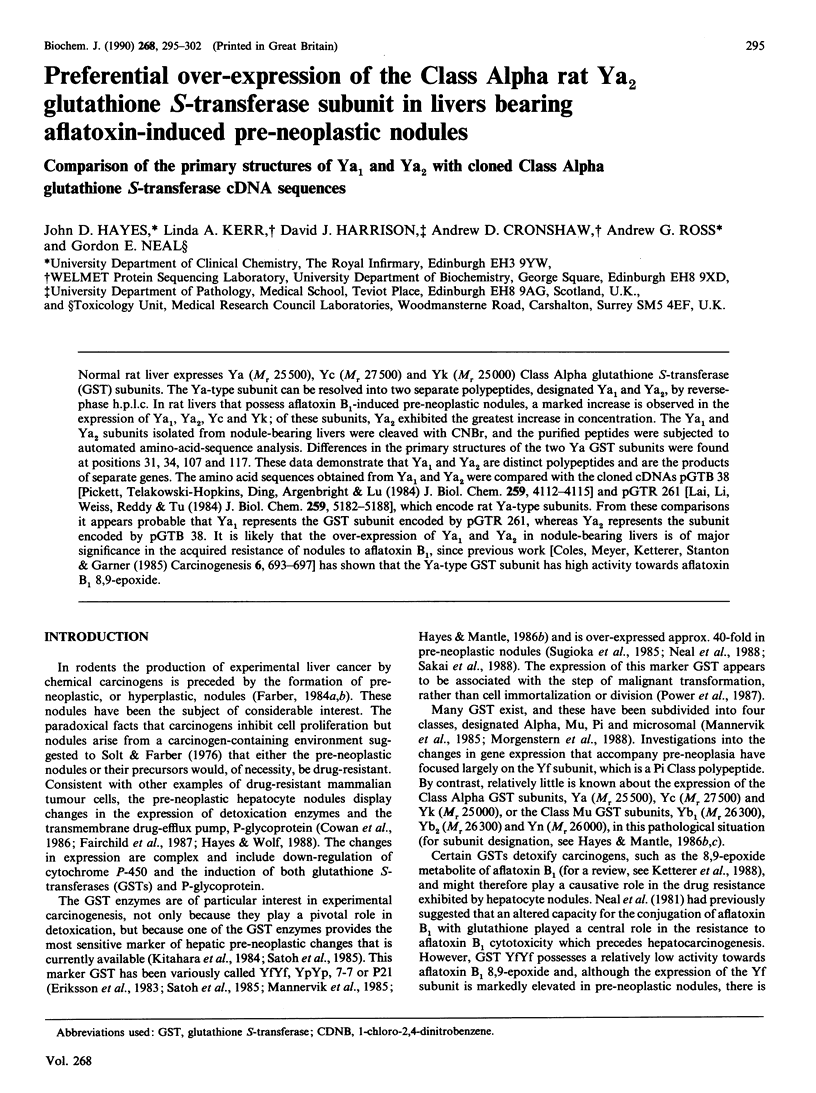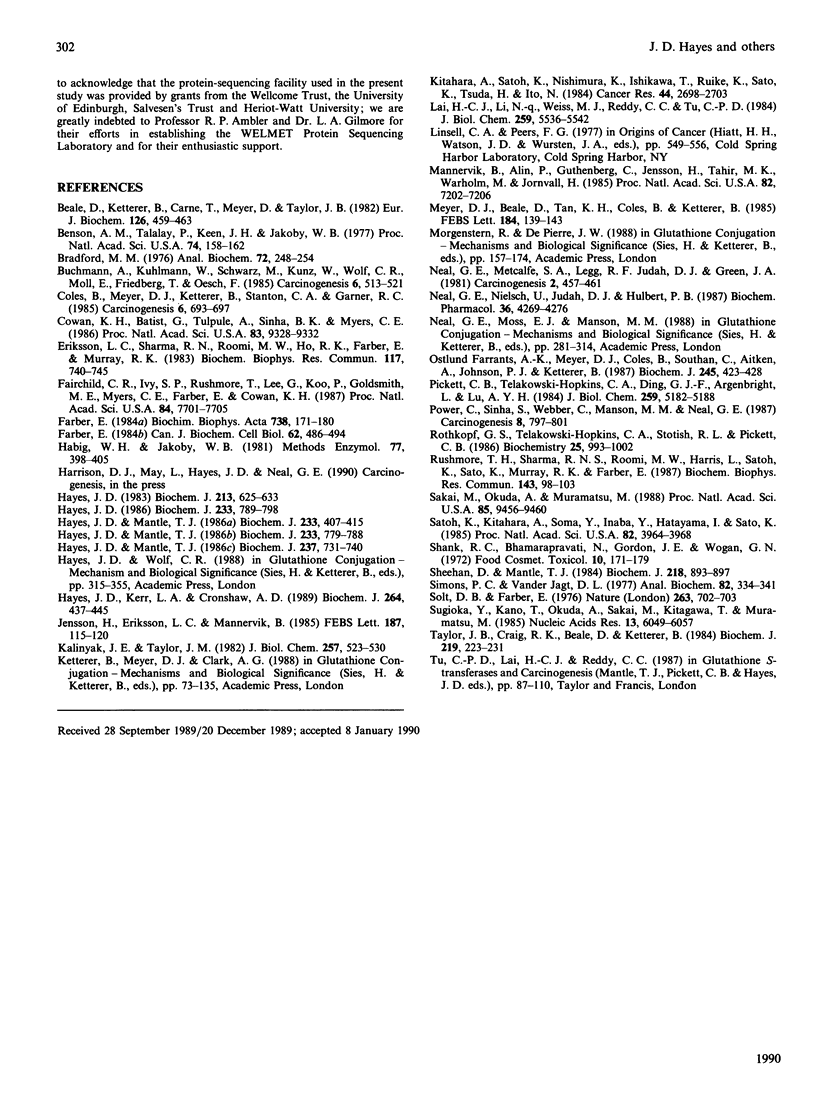Abstract
Normal rat liver expresses Ya (Mr 25,500), Yc (Mr 27,500) and Yk (Mr 25,000) Class Alpha glutathione S-transferase (GST) subunits. The Ya-type subunit can be resolved into two separate polypeptides, designated Ya1 and Ya2, by reverse-phase h.p.l.c. In rat livers that possess aflatoxin B1-induced pre-neoplastic nodules, a marked increase is observed in the expression of Ya1, Ya2, Yc and Yk; of these subunits, Ya2 exhibited the greatest increase in concentration. The Ya1 and Ya2 subunits isolated from nodule-bearing livers were cleaved with CNBr, and the purified peptides were subjected to automated amino-acid-sequence analysis. Differences in the primary structures of the two Ya GST subunits were found at positions 31, 34, 107 and 117. These data demonstrate that Ya1 and Ya2 are distinct polypeptides and are the products of separate genes. The amino acid sequences obtained from Ya1 and Ya2 were compared with the cloned cDNAs pGTB 38 [Pickett, Telakowski-Hopkins, Ding, Argenbright & Lu (1984) J. Biol. Chem. 259, 4112-4115] and pGTR 261 [Lai, Li, Weiss, Reddy & Tu (1984) J. Biol. Chem. 259, 5182-5188], which encode rat Ya-type subunits. From these comparisons it appears probable that Ya1 represents the GST subunit encoded by pGTR 261, whereas Ya2 represents the subunit encoded by pGTB 38. It is likely that the over-expression of Ya1 and Ya2 in nodule-bearing livers is of major significance in the acquired resistance of nodules to aflatoxin B1, since previous work [Coles, Meyer, Ketterer, Stanton & Garner (1985) Carcinogenesis 6, 693-697] has shown that the Ya-type GST subunit has high activity towards aflatoxin B1 8,9-epoxide.
Full text
PDF







Images in this article
Selected References
These references are in PubMed. This may not be the complete list of references from this article.
- Beale D., Ketterer B., Carne T., Meyer D., Taylor J. B. Evidence that the Ya and Yc subunits of glutathione transferase B (ligandin) are the products of separate genes. Eur J Biochem. 1982 Sep 1;126(3):459–463. doi: 10.1111/j.1432-1033.1982.tb06802.x. [DOI] [PubMed] [Google Scholar]
- Benson A. M., Talalay P., Keen J. H., Jakoby W. B. Relationship between the soluble glutathione-dependent delta 5-3-ketosteroid isomerase and the glutathione S-transferases of the liver. Proc Natl Acad Sci U S A. 1977 Jan;74(1):158–162. doi: 10.1073/pnas.74.1.158. [DOI] [PMC free article] [PubMed] [Google Scholar]
- Bradford M. M. A rapid and sensitive method for the quantitation of microgram quantities of protein utilizing the principle of protein-dye binding. Anal Biochem. 1976 May 7;72:248–254. doi: 10.1016/0003-2697(76)90527-3. [DOI] [PubMed] [Google Scholar]
- Buchmann A., Kuhlmann W., Schwarz M., Kunz W., Wolf C. R., Moll E., Friedberg T., Oesch F. Regulation and expression of four cytochrome P-450 isoenzymes, NADPH-cytochrome P-450 reductase, the glutathione transferases B and C and microsomal epoxide hydrolase in preneoplastic and neoplastic lesions in rat liver. Carcinogenesis. 1985 Apr;6(4):513–521. doi: 10.1093/carcin/6.4.513. [DOI] [PubMed] [Google Scholar]
- Coles B., Meyer D. J., Ketterer B., Stanton C. A., Garner R. C. Studies on the detoxication of microsomally-activated aflatoxin B1 by glutathione and glutathione transferases in vitro. Carcinogenesis. 1985 May;6(5):693–697. doi: 10.1093/carcin/6.5.693. [DOI] [PubMed] [Google Scholar]
- Cowan K. H., Batist G., Tulpule A., Sinha B. K., Myers C. E. Similar biochemical changes associated with multidrug resistance in human breast cancer cells and carcinogen-induced resistance to xenobiotics in rats. Proc Natl Acad Sci U S A. 1986 Dec;83(24):9328–9332. doi: 10.1073/pnas.83.24.9328. [DOI] [PMC free article] [PubMed] [Google Scholar]
- Eriksson L. C., Sharma R. N., Roomi M. W., Ho R. K., Farber E., Murray R. K. A characteristic electrophoretic pattern of cytosolic polypeptides from hepatocyte nodules generated during liver carcinogenesis in several models. Biochem Biophys Res Commun. 1983 Dec 28;117(3):740–745. doi: 10.1016/0006-291x(83)91659-5. [DOI] [PubMed] [Google Scholar]
- Fairchild C. R., Ivy S. P., Rushmore T., Lee G., Koo P., Goldsmith M. E., Myers C. E., Farber E., Cowan K. H. Carcinogen-induced mdr overexpression is associated with xenobiotic resistance in rat preneoplastic liver nodules and hepatocellular carcinomas. Proc Natl Acad Sci U S A. 1987 Nov;84(21):7701–7705. doi: 10.1073/pnas.84.21.7701. [DOI] [PMC free article] [PubMed] [Google Scholar]
- Farber E. Pre-cancerous steps in carcinogenesis. Their physiological adaptive nature. Biochim Biophys Acta. 1984;738(4):171–180. doi: 10.1016/0304-419x(83)90002-1. [DOI] [PubMed] [Google Scholar]
- Farber E. The biochemistry of preneoplastic liver: a common metabolic pattern in hepatocyte nodules. Can J Biochem Cell Biol. 1984 Jun;62(6):486–494. doi: 10.1139/o84-066. [DOI] [PubMed] [Google Scholar]
- Habig W. H., Jakoby W. B. Assays for differentiation of glutathione S-transferases. Methods Enzymol. 1981;77:398–405. doi: 10.1016/s0076-6879(81)77053-8. [DOI] [PubMed] [Google Scholar]
- Hayes J. D., Kerr L. A., Cronshaw A. D. Evidence that glutathione S-transferases B1B1 and B2B2 are the products of separate genes and that their expression in human liver is subject to inter-individual variation. Molecular relationships between the B1 and B2 subunits and other Alpha class glutathione S-transferases. Biochem J. 1989 Dec 1;264(2):437–445. doi: 10.1042/bj2640437. [DOI] [PMC free article] [PubMed] [Google Scholar]
- Hayes J. D., Mantle T. J. Anomalous electrophoretic behaviour of the glutathione S-transferase Ya and Yk subunits isolated from man and rodents. A potential pitfall for nomenclature. Biochem J. 1986 Aug 1;237(3):731–740. doi: 10.1042/bj2370731. [DOI] [PMC free article] [PubMed] [Google Scholar]
- Hayes J. D., Mantle T. J. Inhibition of hepatic and extrahepatic glutathione S-transferases by primary and secondary bile acids. Biochem J. 1986 Jan 15;233(2):407–415. doi: 10.1042/bj2330407. [DOI] [PMC free article] [PubMed] [Google Scholar]
- Hayes J. D., Mantle T. J. Use of immuno-blot techniques to discriminate between the glutathione S-transferase Yf, Yk, Ya, Yn/Yb and Yc subunits and to study their distribution in extrahepatic tissues. Evidence for three immunochemically distinct groups of transferase in the rat. Biochem J. 1986 Feb 1;233(3):779–788. doi: 10.1042/bj2330779. [DOI] [PMC free article] [PubMed] [Google Scholar]
- Hayes J. D. Purification and physical characterization of glutathione S-transferase K. Differential use of S-hexylglutathione and glutathione affinity matrices to isolate a novel glutathione S-transferase from rat liver. Biochem J. 1986 Feb 1;233(3):789–798. doi: 10.1042/bj2330789. [DOI] [PMC free article] [PubMed] [Google Scholar]
- Hayes J. D. Rat liver glutathione S-transferases. A study of the structure of the basic YbYb-containing enzymes. Biochem J. 1983 Sep 1;213(3):625–633. doi: 10.1042/bj2130625. [DOI] [PMC free article] [PubMed] [Google Scholar]
- Jensson H., Eriksson L. C., Mannervik B. Selective expression of glutathione transferase isoenzymes in chemically induced preneoplastic rat hepatocyte nodules. FEBS Lett. 1985 Jul 22;187(1):115–120. doi: 10.1016/0014-5793(85)81225-4. [DOI] [PubMed] [Google Scholar]
- Kalinyak J. E., Taylor J. M. Rat glutathione S-transferase. Cloning of double-stranded cDNA and induction of its mRNA. J Biol Chem. 1982 Jan 10;257(1):523–530. [PubMed] [Google Scholar]
- Kitahara A., Satoh K., Nishimura K., Ishikawa T., Ruike K., Sato K., Tsuda H., Ito N. Changes in molecular forms of rat hepatic glutathione S-transferase during chemical hepatocarcinogenesis. Cancer Res. 1984 Jun;44(6):2698–2703. [PubMed] [Google Scholar]
- Lai H. C., Li N., Weiss M. J., Reddy C. C., Tu C. P. The nucleotide sequence of a rat liver glutathione S-transferase subunit cDNA clone. J Biol Chem. 1984 May 10;259(9):5536–5542. [PubMed] [Google Scholar]
- Mannervik B., Alin P., Guthenberg C., Jensson H., Tahir M. K., Warholm M., Jörnvall H. Identification of three classes of cytosolic glutathione transferase common to several mammalian species: correlation between structural data and enzymatic properties. Proc Natl Acad Sci U S A. 1985 Nov;82(21):7202–7206. doi: 10.1073/pnas.82.21.7202. [DOI] [PMC free article] [PubMed] [Google Scholar]
- Meyer D. J., Beale D., Tan K. H., Coles B., Ketterer B. Glutathione transferases in primary rat hepatomas: the isolation of a form with GSH peroxidase activity. FEBS Lett. 1985 May 6;184(1):139–143. doi: 10.1016/0014-5793(85)80670-0. [DOI] [PubMed] [Google Scholar]
- Neal G. E., Metcalfe S. A., Legg R. F., Judah D. H., Green J. A. Mechanism of the resistance to cytotoxicity which precedes aflatoxin B1 hepatocarcinogenesis. Carcinogenesis. 1981;2(5):457–461. doi: 10.1093/carcin/2.5.457. [DOI] [PubMed] [Google Scholar]
- Neal G. E., Nielsch U., Judah D. J., Hulbert P. B. Conjugation of model substrates or microsomally-activated aflatoxin B1 with reduced glutathione, catalysed by cytosolic glutathione-S-transferases in livers of rats, mice and guinea pigs. Biochem Pharmacol. 1987 Dec 15;36(24):4269–4276. doi: 10.1016/0006-2952(87)90669-1. [DOI] [PubMed] [Google Scholar]
- Ostlund Farrants A. K., Meyer D. J., Coles B., Southan C., Aitken A., Johnson P. J., Ketterer B. The separation of glutathione transferase subunits by using reverse-phase high-pressure liquid chromatography. Biochem J. 1987 Jul 15;245(2):423–428. doi: 10.1042/bj2450423. [DOI] [PMC free article] [PubMed] [Google Scholar]
- Pickett C. B., Telakowski-Hopkins C. A., Ding G. J., Argenbright L., Lu A. Y. Rat liver glutathione S-transferases. Complete nucleotide sequence of a glutathione S-transferase mRNA and the regulation of the Ya, Yb, and Yc mRNAs by 3-methylcholanthrene and phenobarbital. J Biol Chem. 1984 Apr 25;259(8):5182–5188. [PubMed] [Google Scholar]
- Power C., Sinha S., Webber C., Manson M. M., Neal G. E. Transformation related expression of glutathione-S-transferase P in rat liver cells. Carcinogenesis. 1987 Jun;8(6):797–801. doi: 10.1093/carcin/8.6.797. [DOI] [PubMed] [Google Scholar]
- Rothkopf G. S., Telakowski-Hopkins C. A., Stotish R. L., Pickett C. B. Multiplicity of glutathione S-transferase genes in the rat and association with a type 2 Alu repetitive element. Biochemistry. 1986 Mar 11;25(5):993–1002. doi: 10.1021/bi00353a007. [DOI] [PubMed] [Google Scholar]
- Rushmore T. H., Sharma R. N., Roomi M. W., Harris L., Satoh K., Sato K., Murray R. K., Farber E. Identification of a characteristic cytosolic polypeptide of rat preneoplastic hepatocyte nodules as placental glutathione S-transferase. Biochem Biophys Res Commun. 1987 Feb 27;143(1):98–103. doi: 10.1016/0006-291x(87)90635-8. [DOI] [PubMed] [Google Scholar]
- Sakai M., Okuda A., Muramatsu M. Multiple regulatory elements and phorbol 12-O-tetradecanoate 13-acetate responsiveness of the rat placental glutathione transferase gene. Proc Natl Acad Sci U S A. 1988 Dec;85(24):9456–9460. doi: 10.1073/pnas.85.24.9456. [DOI] [PMC free article] [PubMed] [Google Scholar]
- Satoh K., Kitahara A., Soma Y., Inaba Y., Hatayama I., Sato K. Purification, induction, and distribution of placental glutathione transferase: a new marker enzyme for preneoplastic cells in the rat chemical hepatocarcinogenesis. Proc Natl Acad Sci U S A. 1985 Jun;82(12):3964–3968. doi: 10.1073/pnas.82.12.3964. [DOI] [PMC free article] [PubMed] [Google Scholar]
- Shank R. C., Bhamarapravati N., Gordon J. E., Wogan G. N. Dietary aflatoxins and human liver cancer. IV. Incidence of primary liver cancer in two municipal populations of Thailand. Food Cosmet Toxicol. 1972 Apr;10(2):171–179. doi: 10.1016/s0015-6264(72)80195-0. [DOI] [PubMed] [Google Scholar]
- Sheehan D., Mantle T. J. Evidence for two forms of ligandin (YaYa dimers of glutathione S-transferase) in rat liver and kidney. Biochem J. 1984 Mar 15;218(3):893–897. doi: 10.1042/bj2180893. [DOI] [PMC free article] [PubMed] [Google Scholar]
- Simons P. C., Vander Jagt D. L. Purification of glutathione S-transferases from human liver by glutathione-affinity chromatography. Anal Biochem. 1977 Oct;82(2):334–341. doi: 10.1016/0003-2697(77)90169-5. [DOI] [PubMed] [Google Scholar]
- Suguoka Y., Kano T., Okuda A., Sakai M., Kitagawa T., Muramatsu M. Cloning and the nucleotide sequence of rat glutathione S-transferase P cDNA. Nucleic Acids Res. 1985 Sep 11;13(17):6049–6057. doi: 10.1093/nar/13.17.6049. [DOI] [PMC free article] [PubMed] [Google Scholar]
- Taylor J. B., Craig R. K., Beale D., Ketterer B. Construction and characterization of a plasmid containing complementary DNA to mRNA encoding the N-terminal amino acid sequence of the rat glutathione transferase Ya subunit. Biochem J. 1984 Apr 1;219(1):223–231. doi: 10.1042/bj2190223. [DOI] [PMC free article] [PubMed] [Google Scholar]



